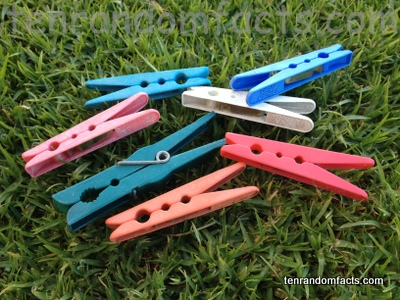Why don’t you pin these clothespin facts?
- Clothespins are devices typically used for attaching clothes to a clothesline or airer.
- ‘Clothespins’ are also known as ‘clothes pins’, ‘clothes-pegs’, ‘clothes pegs’ and ‘pegs’.
- Clothespins are most commonly used for pegging up wet clothes, for the purpose of drying, on washing lines outside.
- Clothespins are believed to have been first patented early in the 1800s, by Jérémie Opdebec, which was the traditional one piece design, and they were commonly made by hand by English gypsies.
- Traditional styled one piece clothespins are usually made of wood although they are sometimes made from plastic, and are often called ‘dolly pegs’, as they were, and still are, also used for making peg dolls.
- The more modern styled clothespin was invented in 1853, by David Smith of Vermont’s Springfield, United States and featured two separate pieces of wood and a spring, and was later improved upon in 1887 by Solon E. Moore.
- Clothespins are often used in children’s craft, and occasionally used in artwork, and have also inspired artists to sculpt enormous pegs.
- Modern clothespins are typically made from plastic with a steel spring, although sometimes they are made from wood.
- Around the house, clothespins are often used for holding a variety of items together, like a clamp, and are also prominently used on film sets.
- Clothespins come in a variety of shapes, sizes and colours, but generally feature a spring, in between two wedge shaped pieces of plastic.
Bibliography:
Clothespin, 2014, Wikipedia, http://en.wikipedia.org/wiki/Clothespin
Greenbaum H & Wilson C, Who made that Clothespin?, 2012, The New York Times, http://www.nytimes.com/2012/05/13/magazine/who-made-that-clothespin.html?_r=0






